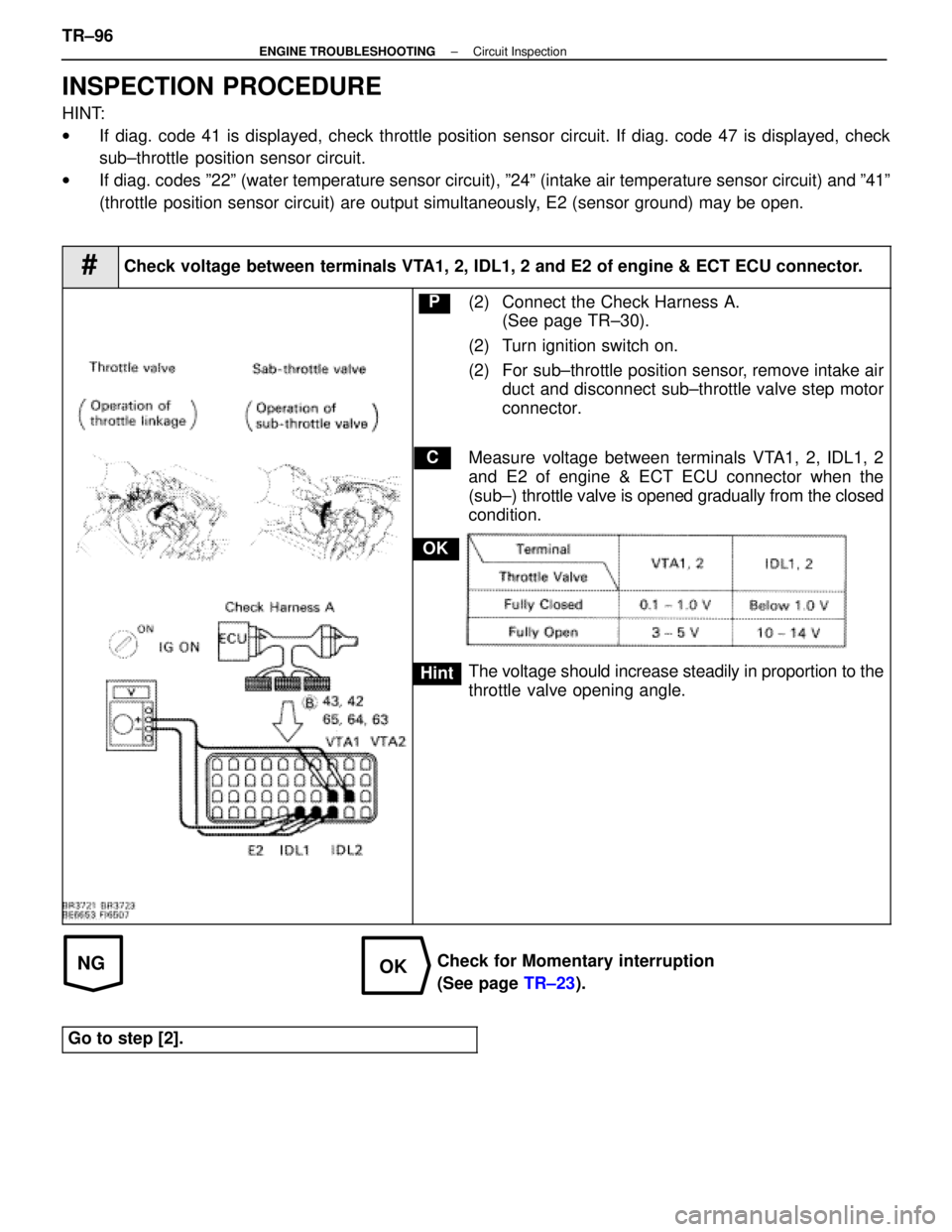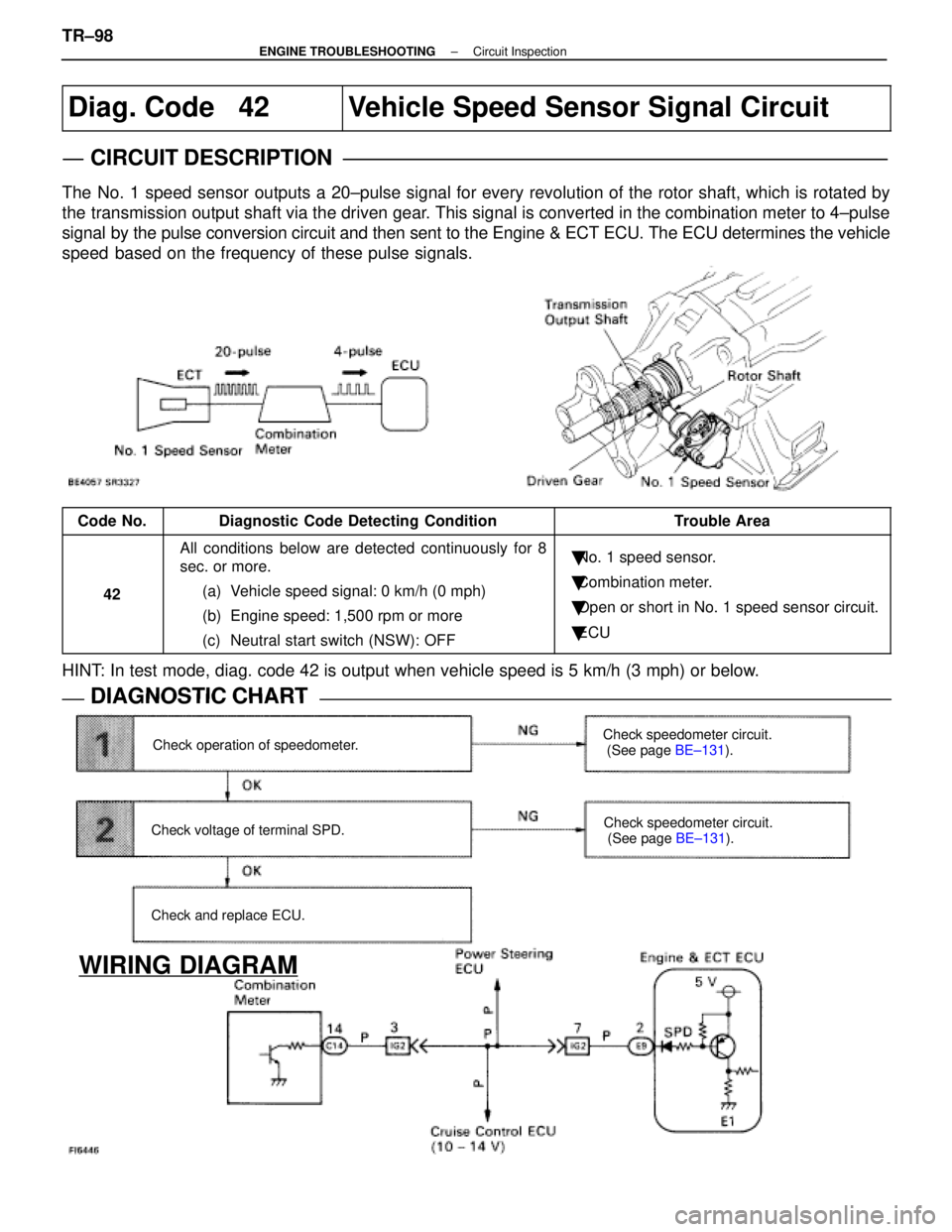Page 3721 of 4087
DIAGNOSTIC CHART
DIAGNOSTIC
CHART
HINT:
wIf diag. code 41 is displayed, check throttle position sensor circuit; if d\
iag. code 47 is displayed,
check sub±throttle position sensor circuit.
w If diag. codes º22º (water temperature sensor circuit), º24º\
(intake air temperature sensor circuit)
and º41º (throttle position sensor circuit) are output simultaneous\
ly, E2 (sensor ground) may be
open.
WIRING DIAGRAM
Check and replace ECU. Adjust or replace throttle position
sensor.
Check for momentary interruption
(See page
TR±23).
Repair or replace harness or
connector.
Check voltage of throttle position sensor.
Check operation for throttle position sensor.
Check for open and short in harness and
connector between throttle position sensor and ECU.
±
ENGINE TROUBLESHOOTING Circuit InspectionTR±95
WhereEverybodyKnowsYourName
Page 3722 of 4087

NGOK
INSPECTION PROCEDURE
HINT:
wIf diag. code 41 is displayed, check throttle position sensor circuit. If \
diag. code 47 is displayed, check
sub±throttle position sensor circuit.
w If diag. codes º22º (water temperature sensor circuit), º24º\
(intake air temperature sensor circuit) and º41º
(throttle position sensor circuit) are output simultaneously, E2 (sensor ground) may be open.
#Check voltage between terminals VTA1, 2, IDL1, 2 and E2 of engine & ECT ECU connector.
C
OK
Hint
P(2) Connect the Check Harness A.
(See page TR±30).
(2) Turn ignition switch on.
(2) For sub±throttle position sensor, remove intake air duct and disconnect sub±throttle valve step motor
connector.
Measure voltage between terminals VTA1, 2, IDL1, 2
and E2 of engine & ECT ECU connector when the
(sub±) throttle valve is opened gradually from the closed
condition.
The voltage should increase steadily in proportion to the
throttle valve opening angle.
Check for Momentary interruption
(See page TR±23).
Go to step [2].
TR±96±
ENGINE TROUBLESHOOTING Circuit Inspection
WhereEverybodyKnowsYourName
Page 3723 of 4087
OKNG
OKNG
2Check (sub±) throttle position sensor.
C
OK
Hint
P(2) Remove intake air duct.
(2) Disconnect (sub±) throttle position sensor connec-tor.
Measure resistance between terminals 3, 2, and 1 of
(sub±) throttle position sensor connector when the
throttle valve is opened gradually from the closed condi-
tion.
Resistance between terminals 3 and 1 should increase
gradually in accordance with the throttle valve opening
angle.
Adjust or replace (sub±) throttle position sensor
(See page FI±73).
3Check for open and short in harness and connector between engine & ECT E\
CU and
(sub±) throttle position sensor (See page IN±27).
Repair or replace harness or connector.
Check and replace engine & ECT ECU.
±
ENGINE TROUBLESHOOTING Circuit InspectionTR±97
WhereEverybodyKnowsYourName
Page 3726 of 4087

Diag. Code 42Vehicle Speed Sensor Signal Circuit
CIRCUIT DESCRIPTION
The No. 1 speed sensor outputs a 20±pulse signal for every revolution of the rotor shaft, which is r\
otated by
the transmission output shaft via the driven gear. This signal is converted in the combination meter to 4±pulse
signal by the pulse conversion circuit and then sent to the Engine & ECT ECU. \
The ECU determines the vehicle
speed based on the frequency of these pulse signals.
Code No.Diagnostic Code Detecting ConditionTrouble Area
42
All conditions below are detected continuously for 8
sec. or more.(a) Vehicle speed signal: 0 km/h (0 mph)
(b) Engine speed: 1,500 rpm or more
(c) Neutral start switch (NSW): OFF�No. 1 speed sensor.
� Combination meter.
� Open or short in No. 1 speed sensor circuit.
� ECU
HINT: In test mode, diag. code 42 is output when vehicle speed is 5 km/h (3\
mph) or below.
DIAGNOSTIC CHARTDIAGNOSTIC CHART
Check operation of speedometer.
Check voltage of terminal SPD.
Check and replace ECU. Check speedometer circuit.
(See page
BE±131).
Check speedometer circuit.
(See page BE±131).
WIRING DIAGRAM
TR±98±
ENGINE TROUBLESHOOTING Circuit Inspection
WhereEverybodyKnowsYourName
Page 3727 of 4087
OKNG
OKNG
1Check operation of speedometer.
Drive the vehicle and check if the operation of the speedometer in the c\
ombination meter is normal.
The No. 1 speed sensor is operating normally if the speedometer display is \
normal.C
Hint
Check speedometer circuit. See combination meter trou-
bleshooting on page BE±131.
2Check voltage between terminal SPD of engine & ECT ECU connector and bod\
y ground.
C
OK
P(2) Shift the shift level to N range.
(2) Jack up a read wheel on one side.
(2) Connect the Check Harness A.
(See page TR±30)
(2) Turn ignition switch on.
Measure voltage between terminal SPD of engine &
ECT ECU connector and body ground when the wheel
is turned slowly.
Voltage is generated intermittently.
Check speedometer circuit. See combination meter trou-
bleshooting on page BE±131.
Check and replace engine & ECT ECU.
±
ENGINE TROUBLESHOOTING Circuit InspectionTR±99
WhereEverybodyKnowsYourName
Page 3730 of 4087

Diag. Code 52,53,55Knock Sensor Circuit
CIRCUIT DESCRIPTION
Knock sensors are fitted one each to the right bank and left bank of the cylinder block to detect\
engine knocking.
This sensor contains a piezoelectric element which generates a voltage when \
it becomes deformed, which oc-
curs when the cylinder block vibrates due to knocking. If engine knocking occurs, ignition timing is retarded to
suppress it.
Code No.Diagnostic Code Detecting ConditionTrouble Area
52No No. 1 knock sensor signal to ECU for 3 crank revolu-
tions with engine speed between 1,600 rpm 5,200 rpm.� Open or short in No. 1 knock sensor circuit.
� No. 1 knock sensor (looseness)
� ECU
53Engine control computer (for knock control) malfunc-
tion at engine speed between 650 rpm and 5,200 rpm.�ECU
55No No. 2 knock sensor signal to ECU for 3 crank revolu-
tions with engine speed between 1,600 rpm 5,200 rpm.�Open or short in No. 2 knock sensor circuit.
� No. 2 knock sensor (looseness)
� ECU
If the ECU detects the above diagnosis conditions, it operates the fail sa\
fe function in which the corrective retard
angle value is set to the maximum value. TR±102
±
ENGINE TROUBLESHOOTING Circuit Inspection
WhereEverybodyKnowsYourName
Page 3731 of 4087
CIRCUIT DESCRIPTION (Cont'd)
DIAGNOSIS CODE DETECTION DRIVING PATTERN
Purpose of the driving pattern.
(a) To simulate diag. code detecting condition after diag. code is recorded.
(b) To check that the malfunction is corrected when the repair is completed c\
onfirming that diag. code is nolonger detected.
Malfunction: Open or Short in Knock Sensor
�Start engine and warm up.
�After engine is warmed up, let it idle for 3 min.
�With the A/C ON, perform quick racing (5,000 rpm) three times.
(Rapidly depress the accelerator pedal and suddenly release it.)
HINT: If a malfunction exists, the ºCHECKº engine warning light will lig\
ht up when sudden racing is performed.
NOTICE: If the conditions in this test are not strictly followed, detection of t\
he malfunction will
not be possible.
±
ENGINE TROUBLESHOOTING Circuit InspectionTR±103
WhereEverybodyKnowsYourName
Page 3732 of 4087
DIAGNOSTIC CHART
HINT: If diag. code 52 is displayed, check No. 1 knock sensor (for left bank)\
circuit.If diag. code 55 is displayed, check No. 2 knock sensor (for right bank\
) circuit.
If diag. code 53 is displayed, replace engine & ECT ECU.
Does malfunction disappear when a good knock
sensor is installed? Repair or replace harness or
connector.
Replace knock sensor.
Check no continuity of knock sensor circuit.
Check knock sensor.
Check for open and short in harness and
connector between knock sensor and ECU.
Replace knock sensor.
Check and replace ECU.
WIRING DIAGRAM
TR±104±
ENGINE TROUBLESHOOTING Circuit Inspection
WhereEverybodyKnowsYourName